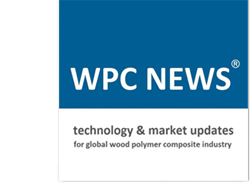Source – Plastemart.com
Wood Plastic Composites (WPCs) are defined as composite materials that contain thermoplastics and wood in various forms. Mostly, either the polymer or the fiber, or both, can come from recycled materials. Because of the limited thermal stability of wood, only plastics that can be processed at temperatures below 392 degrees Fahrenheit are used in WPCs. The average product carries about 50% wood, generally in particulate form, such as wood flour or very short fibers. WPCs represent one of the rapidly growing markets within the plastics industry. Double-digit growth is expected through 2011 for WPCs used as replacement for treated wood in building products and related applications. These composites find usage in a wide range of applications in a number of market sectors including:
– Building and construction
– Garden and outdoor products
– Interiors and internal finishes
– Industrial and infrastructure
– Automotive
– Other low-volume, niche applications
As per a report by Freedonia, demand for wood-plastic composite and plastic lumber is projected to advance about 10% pa through 2011 to US$5.4 bln. These alternative lumber materials are expected to continue to penetrate the building materials market at a rapid pace, particularly in decking applications. Composite and plastic lumber will continue to benefit from their performance characteristics, such as durability, weatherability, low maintenance requirements and low life cycle cost. Demand for composite and plastic lumber will also be driven by increasing consumer and contractor familiarity, a widening distribution network and product improvements that enhance appearance. Furthermore, ongoing interest in “green” building products will bolster use of composite and plastic lumber made with recycled content. Plastic lumber has found significant use in agricultural fencing, molding and trim applications. Solid growth in decking, fencing and other end uses such as site and leisure furniture will continue to support demand going forward. However, WPC lumber will see much faster growth through 2011, posting gains of 14.3% pa to reach US$2.6 bln. Composite lumber demand will be fueled by strong demand in decking applications. In addition, rapid growth in windows and door applications, as well as smaller niche end uses (porches, site and leisure furniture) will support demand going forward. Among the major product categories window and door applications for WPCs are anticipated to post the most rapid gains through 2011 (albeit from a small base). As with other applications, WPC window and door components are making inroads because of their lower maintenance requirements, durability in exterior applications and similarities to wood. Decking applications are projected to see strong gains through 2011, continuing to increase its relative share of the composite and plastic lumber industry. By 2011, decking will be the largest end use for these alternative building materials, accounting for 44% of demand. Molding and trim will remain a key market for composite and plastic lumber, but will exhibit below-average growth through 2011. Increasing market maturity in the plastic lumber segment will limit growth, as will a weak new housing environment going forward. Fencing applications will see below-average gains through 2011, due to increasing market maturity in the plastic lumber segment. All other applications are projected to see rapid growth over the forecast period from small bases. Playground equipment and site and leisure furniture applications are expected to register strong gains through 2011, driven by the environmentally friendly profile of composite and plastic lumber, as well as their performance and maintenance characteristics. The US wood-plastic composite and plastic lumber industry is highly fragmented, consisting of hundreds of companies ranging from small, regional producers to large, national concerns. Manufacturers typically specialize in one type of material, although some companies offer both composite and plastic lumber. In 2006, the leading composite and plastic lumber firms were Louisiana- Pacific, Royal Group Technologies, Tapco International and Trex. US Wood-Plastic Composite & Plastic Lumber Demand (US$3.4 bln, 2006)
Molding & Trim 39%
Windows & Doors 4%
Decking 38%
Fencing 13%
Other Applications 6%
Polyethylene (PE) is most commonly used in exterior applications and Polypropylene (PP) for automotive and consumer applications. The total market for WPC products in the two key market sectors in USA was estimated to exceed US$350 mln in 2001 with predictions to grow. WPC is already an established material in the USA particularly for garden decking and non-structural building applications, such as exterior window and door profiles. The combined value of the North American and Western European WPC markets was US$775 mln in 2002, with demand reaching 1.5 bln lbs. WPCs are projected to grow by 14% pa in North America and by 18% pa in Western Europe through 2010, according to a study by Principia Partners LLC. The North American market for WPCs accounted for over 85% of the combined North American and Western European demand in 2002. Building products represent the largest segment in the North America WPC market, accounting for more than 80% of consumption. In these applications, WPCs are used in decking and railing systems, window and door profiles and shingles. Infrastructure application was the second largest segment, at over 125 mln lbs. Primary applications in this segment are for boardwalks, docks and related structures.
As per another report by Freedonia, although demand for wood decking in the US is projected to advance less than 1% pa through 2013, demand for alternative decking will grow nearly 10% pa. Demand for wood-plastic composite decking is forecast to rise 9.5% pa to 700 million lineal feet, while demand for plastic and other decking is projected to advance 9.7% pa to 135 million lineal feet in 2013. Overall, demand for decking will reach 3.6 billion lineal feet, valued at US$5.2 bln. Consumers will be attracted to alternative decking materials because of their long lifespans, minimal maintenance requirements, and imperviousness to degradation caused by general wear and tear and long-term exposure to moisture. In addition to its performance characteristics, gains in demand for composite decking will be encouraged by its close resemblance to natural wood, its ability to be cut like wood decking, and the perception that it is an environmentally friendly material, due to the use of reclaimed plastics in its production. Advances in demand for plastic decking will be driven by the high durability of this product, making it ideal for use in public parks, commercial spaces, and such facilities as dockyards and marinas. Wood decking will continue to account for the majority of decking demand in volume and value terms. Demand for wood decking is forecast to rise less than 1% pa to 2.8 bln lineal feet in 2013. Advances will be restrained by heavy competition from other materials, although increasing consumer interest in tropical hardwoods will offer some bright spots. The residential market, which accounted for 61% of total decking demand in 2008, will continue to account for the majority of decking demand through 2013, posting 2.6% annual growth rates. Advances will be boosted by consumers adding amenities to their existing decks, such as outdoor kitchens, spas and hot tubs, and areas for other activities. Not only do these larger decks require deck boards, but many homeowners will install additional railings and other accessories to separate areas of the deck, in order to enhance the safety of their decks by preventing falls by small children or older adults. Further gains will be derived from an expected recovery in new housing construction from the low level in 2008.

